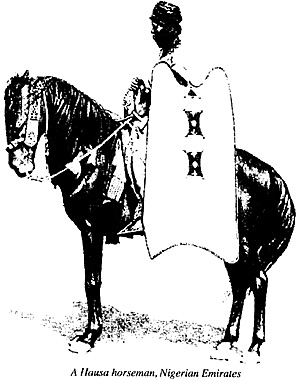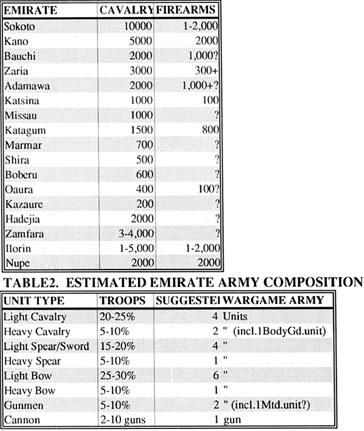
Ian Knight's book, Queen Victoria's Enemies (2), offers a bit of information and a couple of pictures of the cavalry of the Nigerian Emirates. I have come across a book, Warfare in the Sokoto Caliphate which provides a much more detailed look at these interesting African armies.
A Hausa horseman, Nigerian Emirates
EARLY HISTORY
In 1804 the Shehu, a charismatic Fulani muslim scholar, called for a jihad, and by 1817 had overthrown all the Hausa rulers, unifying the Hausa states into a multiethnic and multistate empire. Although the nomadic Fulani constituted only 1/6th of the population, they were more united and all able bodied males served in the revolutionary army.
The Shehu himself was not a warrior. He appointed capable relatives and Fulani leaders to be military commanders and administrators. They were given flags (Tuta) blessed by the Shehu, which were their symbol of muslim leadership and command rank. Without a flag, no man could legitimately claim to be a lieutenant of the Shehu.
The original flag bearers became provincial army commanders (amir al-jaish) for military regions. These senior commanders in turn deputized subordinates of their own, (hakimai) who were given flags signifying their authority and subordination. The regional flag bearers became the founders of ruling dynasties of the various emirates that made up the Sokoto Caliphate. They were closely linked by ties of kinship, muslim scholarship, and personal allegiance.
The Fulani were nomadic cattle herders, who were widely distributed throughout the Sudnic states. Some settled among and intermarried with Hausa and others. The Hausa were sedentary agriculturalists, but good fighters. Hausa mercenaries served in many African and colonial armies. The Tuareg were linked to the Fulani through learned leaders sharing a common religion and used Arabic as a common tongue. Tuareg allies often augmented the Caliphate armies with sizable contingents of camel cavalry.
 ARMY ORGANIZATION
ARMY ORGANIZATION
Each emirate had its own army. The Caliph in Sokoto had the authority to call up all the emirate armies for a war, but due to distance and logistics this was not practical.
The army organization and state structure of the Sokoto Caliphate were patterned after the classical Hausa society, and remained intact until the British conquest. There was no standing army except for the slaves of the emirs and officials. All the mounted fief holders and courtiers had a compulsory military obligation. They received their arms and equipment from the State. The free peasantry was under no specific military obligation, but thousands usually volunteered for campaigns.
During the early years of the had, all the Fulani warriors were foot archers and spearmen, who won battles with their missile fire. As the victorious armies captured horses and armor, they put them into use and shock action became increasingly important.
Cavalry (dawaki) became the premier arm. Because horses and armor were expensive to import and maintain, cavalry was an aristocratic weapon system, controlled by a privileged minority, who dominated the political and military system of the Caliphate. The wealthy also equipped some of their select slaves as cavalrymen. An additional source of mounted men were mercenaries.
Armies of the Sokoto Caliphate The Yucatan Indian Uprising 1847-1855
- Introduction and Army Organization
Cavalry
Infantry and Artillery
Officers and Fortifications
The Warfare State
The British Invasions 1897-1903
Wargaming
Back to Table of Contents -- Savage and Soldier Vol. XXIII No. 3
Back to Savage and Soldier List of Issues
Back to MagWeb Magazine List
© Copyright 1992 by Milton Soong.
This article appears in MagWeb.com (Magazine Web) on the Internet World Wide Web.
Other articles from military history and related magazines are available at http://www.magweb.com